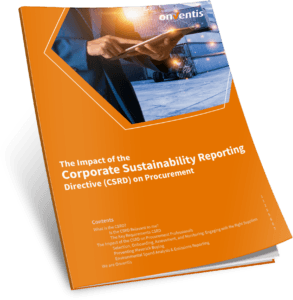What is the Greenhouse Gas Protocol (GHG Protocol)?
The Greenhouse Gas Protocol (GHG Protocol) was launched in 1998 by the World Resources Institute (WRI) and the World Business Council for Sustainable Development (WBCSD). The GHG Protocol helps organizations report on climate change and related impacts. By standardizing reporting, organizations have a consistent approach to evaluate and report their impact on climate change. The GHG Protocol is now recognized worldwide as a framework for measuring and reporting greenhouse gas emissions and is closely linked to the Corporate Sustainability Reporting Directive (CSRD).
Fact Sheet: Impact of the CSRD on Procurement

The three emission scopes in the GHG Protocol
The GHG Protocol divides greenhouse gas emissions into three scopes:
- Direct Emissions: For example, emissions from combustion processes on the company premises or emissions from company transport vehicles.
- Indirect Emissions from Energy Use: Emissions arising from the generation of purchased electricity, steam, and heat produced by external sources. These emissions are related to the energy that the organization purchases.
- Other Indirect Emissions: Emissions related to the activities of the organization but occurring outside the direct control or ownership of the organization. This includes emissions in the supply chain, employee commuting, business travel, and other indirect emissions.
Each of these scopes is further subdivided into subcategories. The GHG Protocol does not require reporting on all categories. However, it is important to get the most prominent categories in view and calculate the emissions for them. This will give you a good idea of the impact of your company on the climate.
The GHG Protocol and the CSRD
In December 2019, the European Green Deal was launched. This is a package of policy initiatives aimed at making Europe the world’s first “climate-neutral continent” by 2050. The CSRD is a directive that is central to the Green Deal and aims to provide more transparency and better quality of sustainability information. This directive is being converted into Dutch legislation.
The CSRD requires that sustainability be part of the annual report of organizations. This annual report must include reporting on the three emission scopes as defined in the GHG Protocol. Integration of the GHG Protocol helps to meet the CSRD requirements for emission reporting and also shows where opportunities for reducing emissions lie.
THE GHG PROTOCOL AND THE PROCUREMENT FUNCTION: CALCULATING SCOPE 3 EMISSIONS
The CSRD will have a major impact on procurement and supply chain professionals. This is partly because scope 3 emissions must be calculated. As mentioned, these include emissions in the supply chain. To calculate these, you can use spend data.
You do this by classifying spend into categories. You can then use market data to calculate how many emissions one euro of spend in a particular category leads to. Online, there are various databases available that show which emission factors should be applied to which spend category.
For the spend analysis, you can use Excel or one of the various software solutions available. It is important that the tool is able to categorize purchases to gain insight into which procurement categories the organization should focus on to reduce them.
Stay tuned for more CSRD information
Take the next step towards CSRD-compliance with Onventis. Gain more knowledge of the impact of the CSRD on procurement and supply chain by following us on LinkedIn or subscribe to our newsletter.
Weitere BlogsMore BlogsMeer blogs



